In the spring and summer months when warblers arrive, New Brunswick is a common habitat for yellow birds, but during the winter season, the American Goldfinch stands out as the most frequently seen yellow bird in the area.
To assist you in identifying the yellow birds you spot in New Brunswick, this guide provides you with pictures, identification details, song recordings, and migration patterns.
Warblers, orioles, and tanagers make up the majority of the yellow birds found in New Brunswick, with some female birds displaying distinct differences from their male counterparts.
By utilizing the information presented in this guide, identifying yellow birds will become a much simpler task. The listed yellow birds are organized according to their frequency of sightings in New Brunswick during the spring and summer months, based on ebird checklists (May and June).
Yellow birds present in New Brunswick throughout the year include the American Goldfinch and Evening Grosbeak.
During the summer season, the following yellow birds can be found in New Brunswick: Common Yellowthroat, Yellow-rumped Warbler, Cedar Waxwing, American Redstart, Yellow Warbler, Black-throated Green Warbler, Magnolia Warbler, Nashville Warbler, Palm Warbler, Cape May Warbler, Baltimore Oriole, Pine Warbler, Canada Warbler, and Eastern Meadowlark.
Yellow birds passing through New Brunswick during migration include Wilson’s Warbler, Orange-crowned Warbler, and Scarlet Tanager.
So, read on to identify those yellow birds you’ve spotted!
List of 19 Yellow Birds in New Brunswick:
1. American Goldfinch
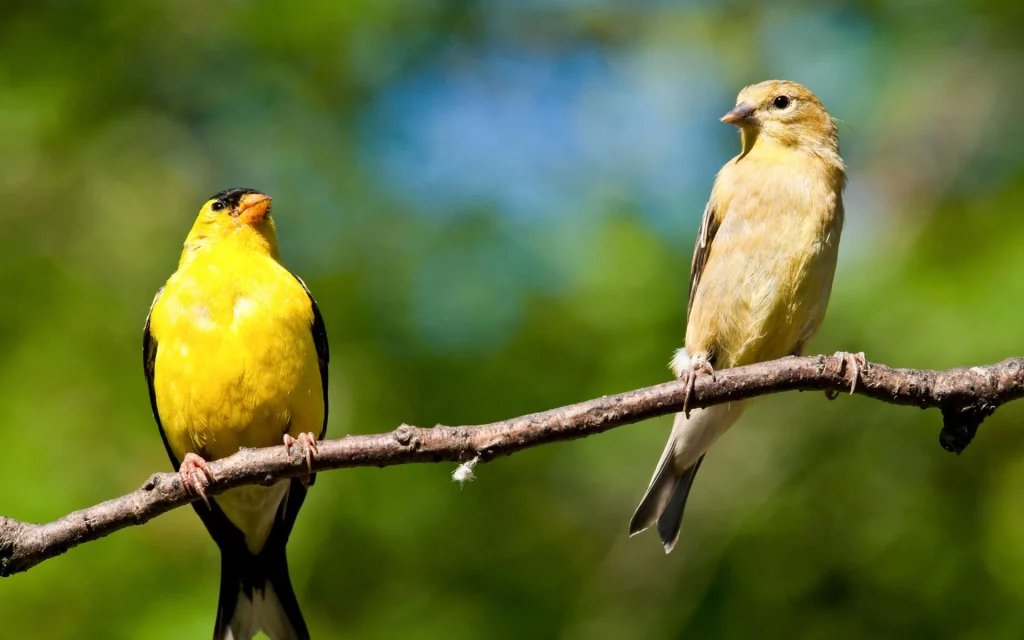
For identification purposes, the American Goldfinch exhibits bright yellow and black plumage during the spring. However, the males become less vibrant in the winter, resembling the duller brown coloration of the females.
The American Goldfinch, scientifically known as Spinus tristis, can be found across North America and is typically a year-round resident. However, those breeding in Canada and the Midwest migrate to the southern United States for the winter.
These goldfinches are commonly seen in weedy fields, overgrown areas, suburbs, parks, and even backyards, where they forage for sunflower, thistle, and aster plants. Their presence is noted in 38% of summer checklists and 28% of winter checklists submitted by bird enthusiasts in New Brunswick.
2. Common Yellowthroat
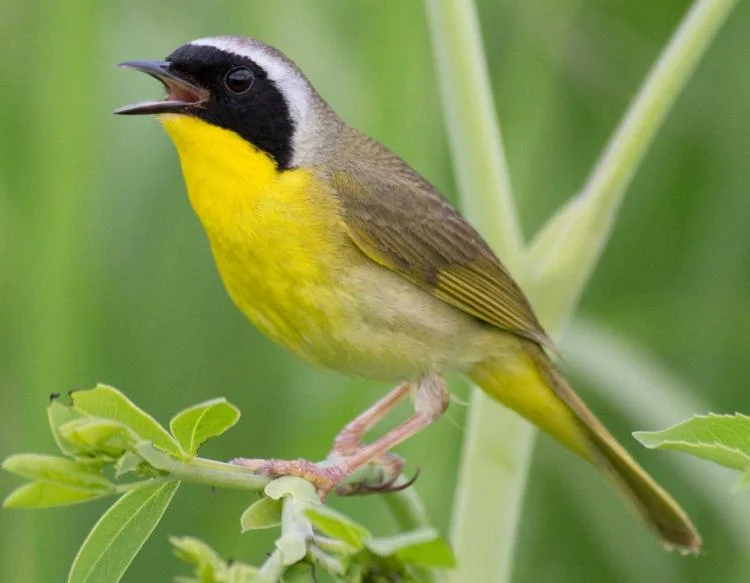
During the breeding season, the Common Yellowthroat is a prevalent sight in New Brunswick, appearing in 24% of summer checklists. They can be spotted from April to October, with some individuals lingering until December.
These small songbirds possess a brownish back and vibrant yellow underparts, featuring long tails. The males are distinguished by their black masks, while the intensity of the yellow coloration can vary geographically, sometimes appearing more olive.
The scientific name of the Common Yellowthroat is Geothlypis trichas, and they breed across most of North America, excluding Alaska and northern Canada. Some populations remain along the Gulf Coast and Pacific Southwest throughout the year, while others migrate south for winter.
Common Yellowthroats can often be found in marshy or wetland areas, as well as brushy fields, thriving amidst thick, tangled vegetation.
3. Yellow-rumped Warbler
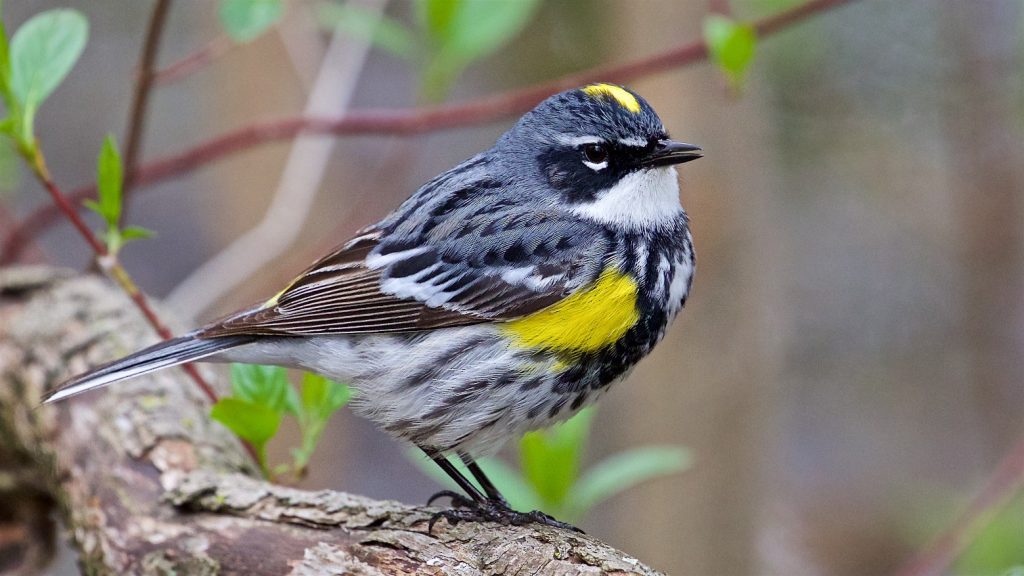
Yellow-rumped Warblers can be spotted in New Brunswick during the breeding season, but their numbers increase significantly during migration in May and from September to October. They appear in 19% of summer checklists and up to 34% of checklists during migration.
These warblers display gray plumage with flashes of yellow on their faces, sides, and rumps, while their wings exhibit white patches. Females may appear slightly brown, and winter birds tend to be paler brown with bright yellow rumps
and sides, transitioning back to a gray and yellow combination in the spring.
Scientifically known as Setophaga coronata, Yellow-rumped Warblers breed primarily in Canada, the Rockies, and the Appalachian Mountains. During migration, they can be observed in the Midwest before wintering in southern and southwestern U.S. states, the Pacific Coast, Mexico, and Central America.
These warblers inhabit coniferous forests, especially during the breeding season. In the winter, they can be found in open areas with fruiting shrubs. Their diet consists mainly of insects in the summer and fruit, including bayberry and wax myrtle, during migration and winter.
4. Cedar Waxwing

During the breeding season, Cedar Waxwings can be seen in New Brunswick, primarily from June to September. Some individuals remain year-round, and they are recorded in 16% of summer checklists and 1% of winter checklists.
These elegant, sociable birds showcase a pale brown head, chest, and crest that transitions to gray on their backs and wings. Their bellies feature a pale yellow hue, and they sport bright yellow tips on their tails. A narrow black mask accentuates their eyes, and their wingtips display a vibrant shade of red.
Scientifically referred to as Bombycilla cedrorum, Cedar Waxwings breed in Canada before migrating to the southern United States, Mexico, and Central America for winter. They remain resident year-round in northern U.S. states.
Cedar Waxwings can be found in berry bushes, woodlands, grasslands, towns, and along streams. While they mainly feed on fruit, they also consume insects during the summer.
5. American Redstart Female

During the summer months, American Redstarts can be observed in New Brunswick, appearing in 21% of checklists from May to November.
Male American Redstarts exhibit predominantly black plumage with bright orange patches and a white belly. Females, on the other hand, possess an olive-gray coloration, featuring various yellow patches.
Scientifically known as Setophaga ruticilla, American Redstarts breed in eastern U.S. states and Canada, extending to northwestern U.S. states. They may also be seen during migration in central and western U.S. states. For the winter, they mainly inhabit Mexico.
These redstarts can be found in deciduous woodlands, backyards, and thickets, where they feed on insects and berries such as serviceberry and magnolia.
6. Yellow Warbler
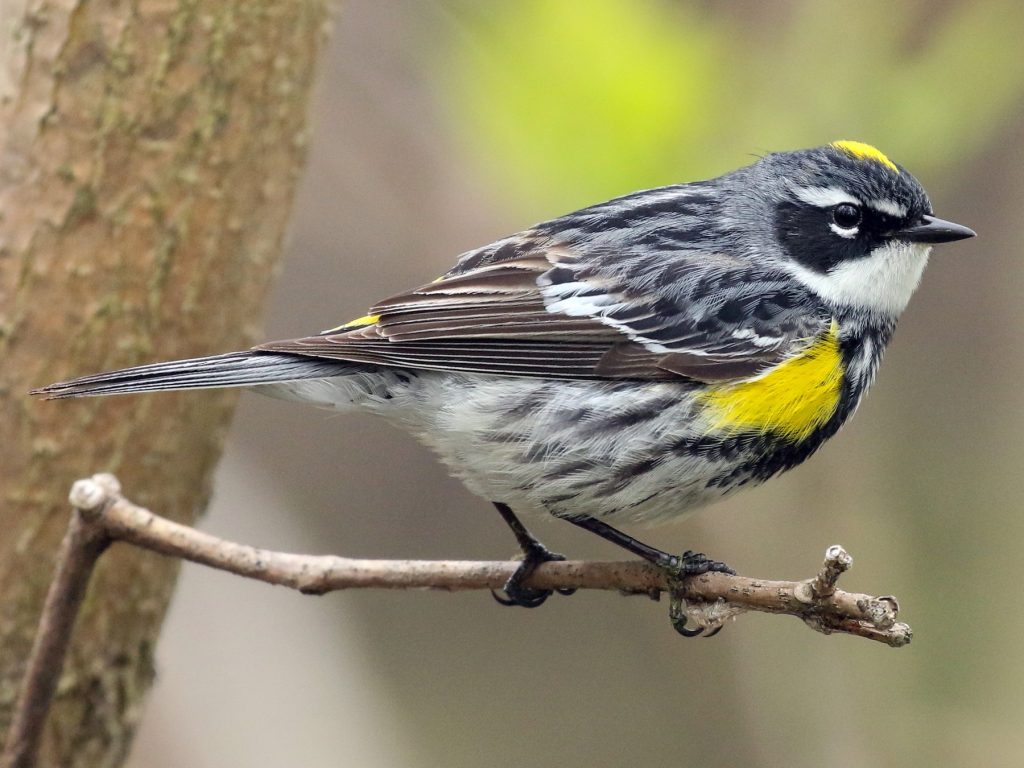
Yellow Warblers are frequently observed in New Brunswick during the breeding season, spanning from May to October. They occur in 21% of summer checklists.
These small, bright yellow birds possess a yellow-green back, with males displaying chestnut streaks on their breasts. Females and juveniles exhibit less vibrant coloration compared to males.
Scientifically referred to as Setophaga petechia, Yellow Warblers undertake long-distance migrations to breed in Canada and the United States, excluding southeastern states. They then journey back to Central and South America for the winter. However, they can be spotted during migration in southeastern U.S. states.
Yellow Warblers are commonly found along streams, wetlands, and thickets, foraging for insects such as caterpillars, midges, beetles, bugs, and wasps.
7. Black-throated Green Warbler
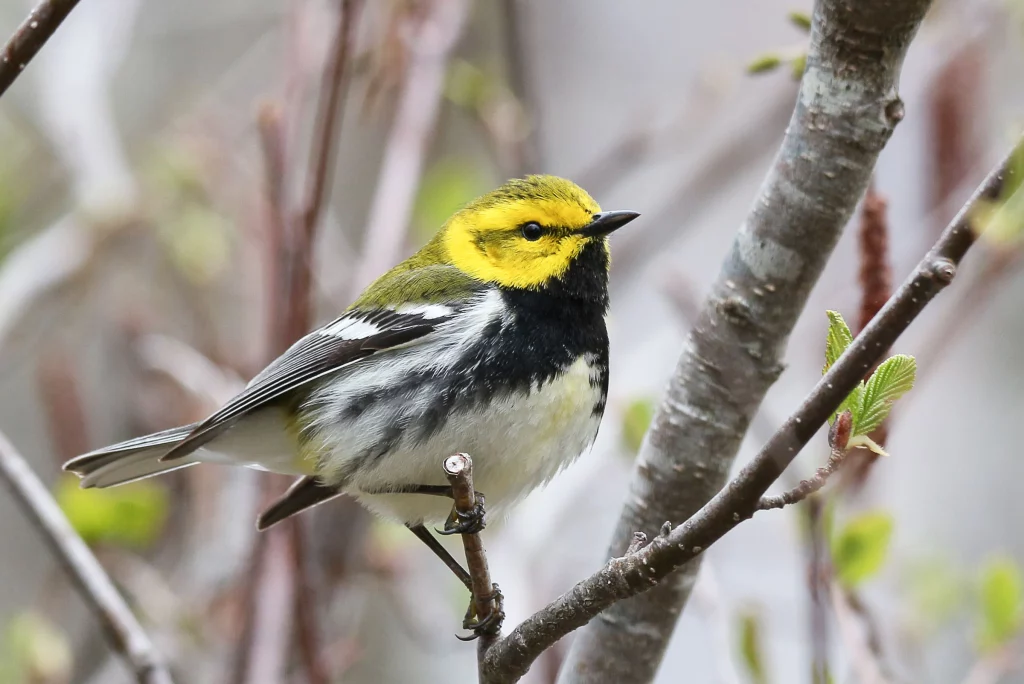
Black-throated Green Warblers spend their summers in New Brunswick and are mainly observed from May to October. They are present in 15% of checklists during this period.
These small yellow songbirds possess yellow faces and heads, with olive-yellow backs. They exhibit black streaking on their sides and wings, while their undersides appear whitish. Male individuals sport large black patches
on their throats, while females and juveniles display smaller patches.
Scientifically referred to as Setophaga virens, Black-throated Green Warblers can primarily be seen during their extensive migration across the eastern United States, reaching their breeding grounds in northeastern U.S. states and Canada. They winter in Mexico, northern South America, and the Caribbean.
Black-throated Green Warblers can be found high up in forests, where they feed on insects. Their distinctive black throat serves as a distinguishing feature from other small yellow birds.
8. Magnolia Warbler
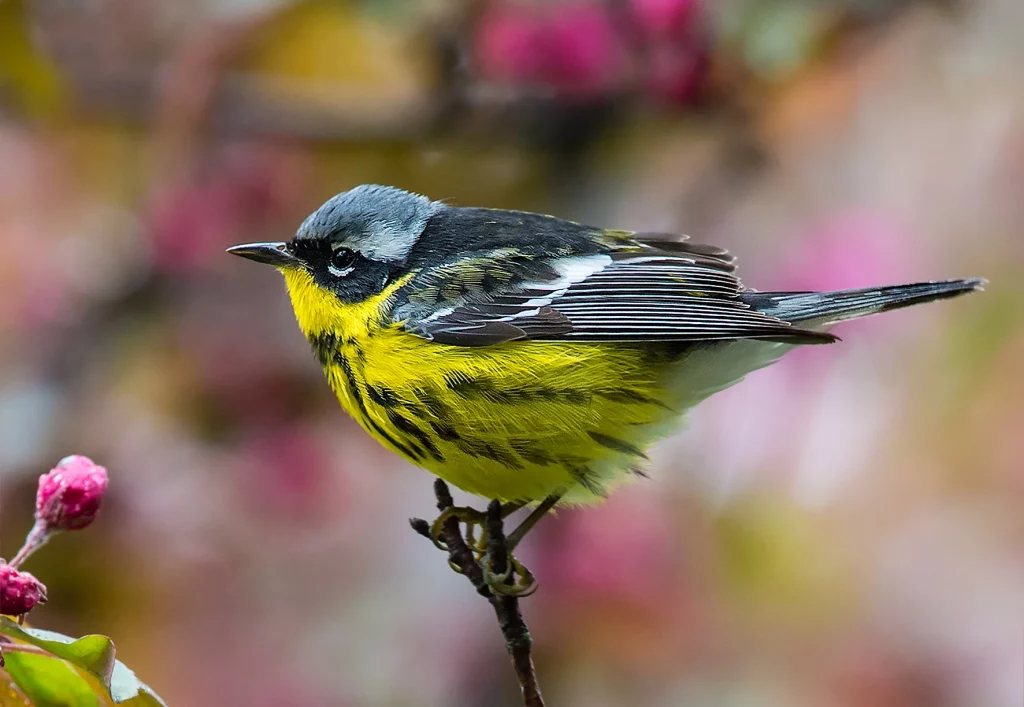
Magnolia Warblers can be observed in New Brunswick from May to October, occurring in 10% of summer checklists.
Male Magnolia Warblers display a black back and yellow undersides, with black streaking forming a “necklace” across their necks and bellies. Females exhibit grayer backs and lack the distinctive streaking on their bellies.
Scientifically known as Setophaga magnolia, Magnolia Warblers breed across Canada and northeastern U.S. states. They can be seen during migration in the eastern United States and spend their winters in Central America and the Caribbean.
These warblers can be found perched on low branches in forests or parks, making them easier to spot during migration. They primarily feed on insects and spiders.
9. Nashville Warbler
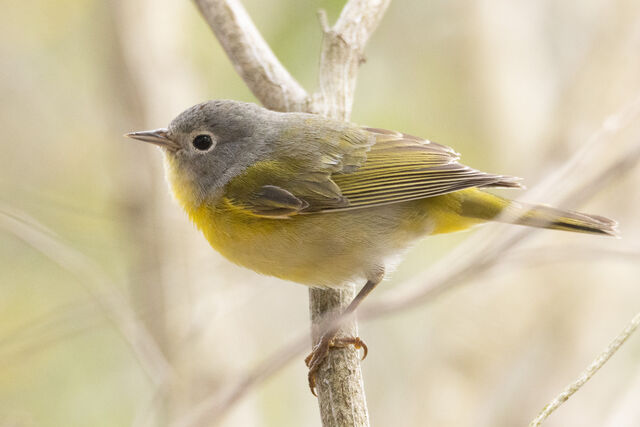
Nashville Warblers are spotted during the breeding season in New Brunswick, primarily from May to October, and appear in 5% of summer checklists.
These warblers feature predominantly yellow undersides with white lower bellies. They possess a greenish-yellow back, gray head, and a white eyering. Females and juvenile males exhibit less vibrancy compared to adult males.
Scientifically referred to as Leiothlypis ruficapilla, Nashville Warblers breed in northeastern U.S. states and Canada, with a smaller population found in northwestern U.S. states and British Columbia. They can also be observed during migration in most U.S. states. Their winter grounds are primarily in Mexico.
Nashville Warblers can be found in scrubby habitats and low deciduous forests, where they hunt for insects.
10. Evening Grosbeak
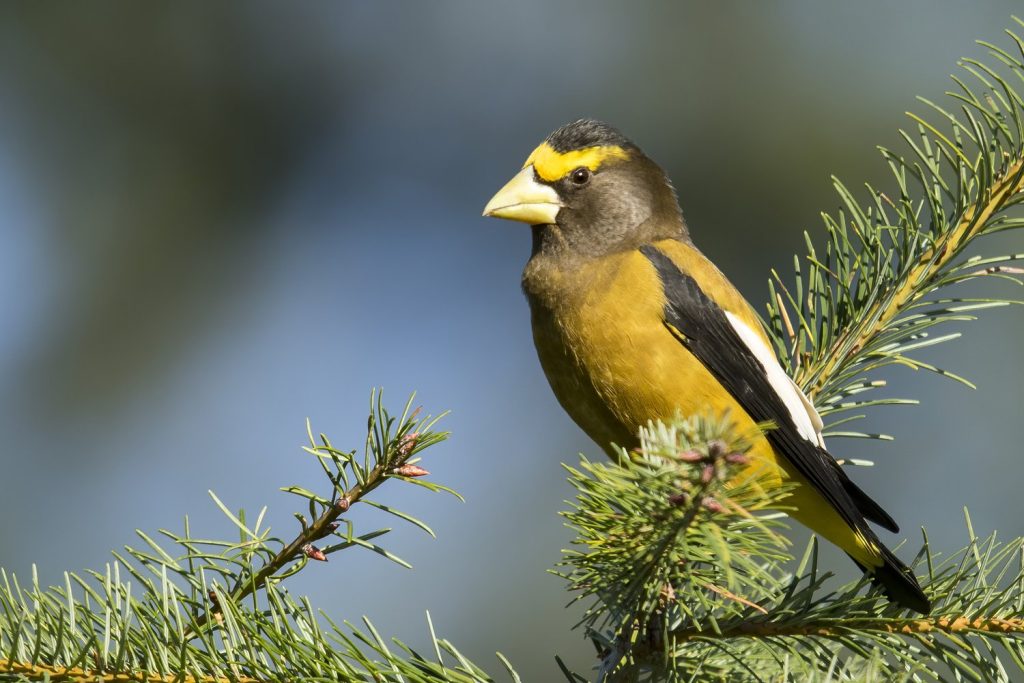
Evening Grosbeaks are considered vulnerable species in New Brunswick, and while they can be spotted throughout the year, they are more commonly seen during winter in the southern part of the province. They occur in 1% of summer checklists and 4% of winter checklists.
These chunky birds exhibit a striking yellow and black pattern, with adult males sporting a bright yellow stripe over their eyes, giving them a fierce appearance. Their heads are black, with gray necks, and their chest and belly are yellow. Additionally, they possess a white patch on their wings.
Females and juvenile males have greenish bills, gray bodies, black and white wings, and a yellow tinge on the neck.
Scientifically known as Hesperiphona vespertina, Evening Grosbeaks remain resident year-round in southern Canada, extending down the west coast to northern California. However, when cone crops are scarce, they migrate south to various U.S. states.
These grosbeaks inhabit forests and mountainous regions. During winter, they are often attracted to backyard feeders, taking advantage of easily accessible food sources.
11. Palm Warbler
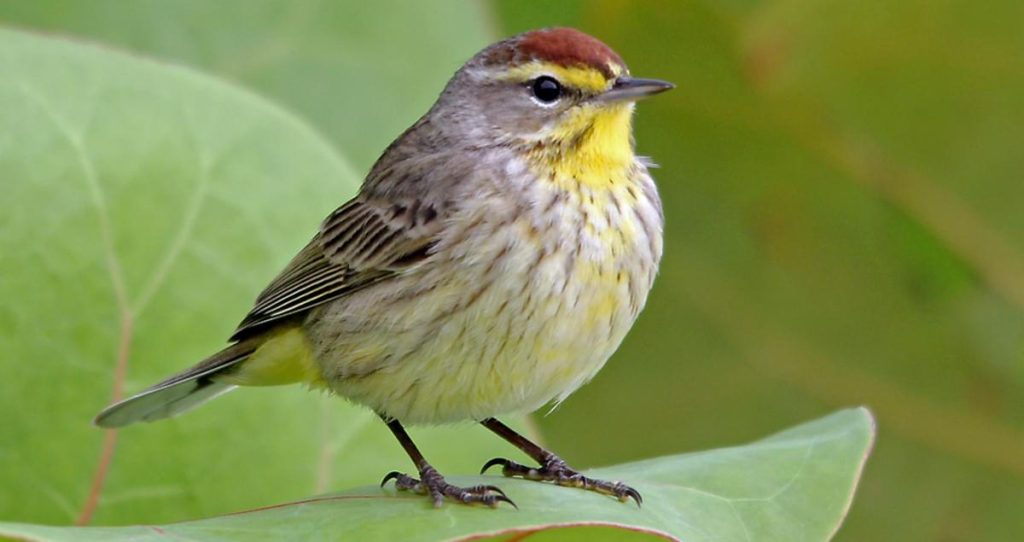
From April to October, Palm Warblers grace the landscapes of New Brunswick, with a handful of individuals lingering until December. These delightful birds flaunt a rusty red patch atop their heads and sport a brownish-olive hue across their bodies. While they breed in Canada, during migration, they make appearances in eastern states, and some can be found year-round along the southern coast and in Florida.
Scientifically known as Setophaga palmarum, Palm Warblers measure around 4.7-5.5 inches (12-14 cm) in length and weigh approximately 0.3-0.5 ounces (7-13 g). With a wingspan of 7.9-8.3 inches (20-21 cm), these warblers primarily breed in Canada and can be observed during migration in eastern US states. Some individuals choose to winter in Florida and along the southeastern coast.
You can spot Palm Warblers during their spring and fall migration in weedy fields, forest edges, and scrubby areas. They are often seen foraging on the ground for insects, often mingling with other birds like Sparrows, Juncos, and Yellow-rumped Warblers.
To attract Palm Warblers to your backyard, consider planting native plants that attract insects, as well as bayberry or hawthorn for their berries.
Fun Fact: Unlike most warblers, Palm Warblers have a unique behavior of walking on the ground while bobbing their tails, all the while searching for insects.
12. Cape May Warbler

The breeding season in New Brunswick is enlivened by the presence of Cape May Warblers, primarily from May to October. These beautiful birds grace approximately 1% of summer checklists.
Male Cape May Warblers possess distinctive features such as chestnut cheeks, dark caps framing a yellow neck, and mottled yellow-olive upperparts. Their undersides exhibit yellow with dark streaks. Meanwhile, females exhibit a similar pattern but with paler back feathers and a less prominent “necklace.”
Scientifically referred to as Setophaga tigrina, Cape May Warblers measure around 4.7-5.1 inches (12-13 cm) in length and weigh approximately 0.4-0.5 ounces (10.2-15.2 g). With a wingspan of 7.9-8.7 inches (20-22 cm), these warblers undertake migratory journeys from breeding grounds in Canada over eastern US states. For the winter, they migrate to the Caribbean and a narrow band along the Yucatan Peninsula and Central America.
Cape May Warblers can be found in spruce forests during their breeding period. However, during migration, they can be spotted in various habitats, particularly near woodland edges and scrubby areas where they can find abundant insects.
Their diet primarily consists of spruce budworm during the summer, but in winter, they shift to consuming fruit, nectar, and even visit hummingbird feeders.
To attract Cape May Warblers to your backyard, consider planting native shrubs and trees that attract insects. Additionally, they do not shy away from visiting fruit feeders and hummingbird feeders.
Fun Fact: Cape May Warblers possess specially shaped tongues that are adapted for lapping up nectar, forming a unique tube-like structure.
13. Baltimore Oriole Female

The summer season in New Brunswick brings forth the vibrant presence of Baltimore Orioles, gracing approximately 2% of checklists during this time.
Baltimore Orioles serve as a colorful harbinger of spring in the eastern part of North America. The adult males don bright orange plumage with black wings and white wing bars.
Female Baltimore
Orioles exhibit yellowish undersides and heads, with grayish-brown wings. Their backs showcase a brownish-yellow hue. These slender birds are roughly the size of Robins and belong to the blackbird family.
Scientifically known as Icterus galbula, Baltimore Orioles measure around 6.7-7.5 inches (17-19 cm) in length and weigh approximately 1.1-1.4 ounces (30-40 g). With a wingspan of 9.1-11.8 inches (23-30 cm), they breed across Eastern and Central States, including central-southern Canadian provinces and the southern border with the US.
Following the breeding season, Baltimore Orioles embark on a migration to wintering grounds in Florida, Central America, and the Caribbean, often beginning as early as July.
Baltimore Orioles can be found perched high in open woodlands, along riverbanks, and forest edges, where they forage for insects and fruit. They frequently visit parks and backyard settings.
Their diet primarily consists of insects such as beetles, crickets, grasshoppers, spiders, and snails. While they contribute to pest control by consuming pest species, they also enjoy a wide variety of fruits. However, it’s worth noting that they can occasionally cause damage to crops like raspberries, mulberries, cherries, bananas, and oranges.
Fun Fact: Baltimore Orioles construct impressive hanging nests resembling bags, expertly woven from fibers.
14. Pine Warbler
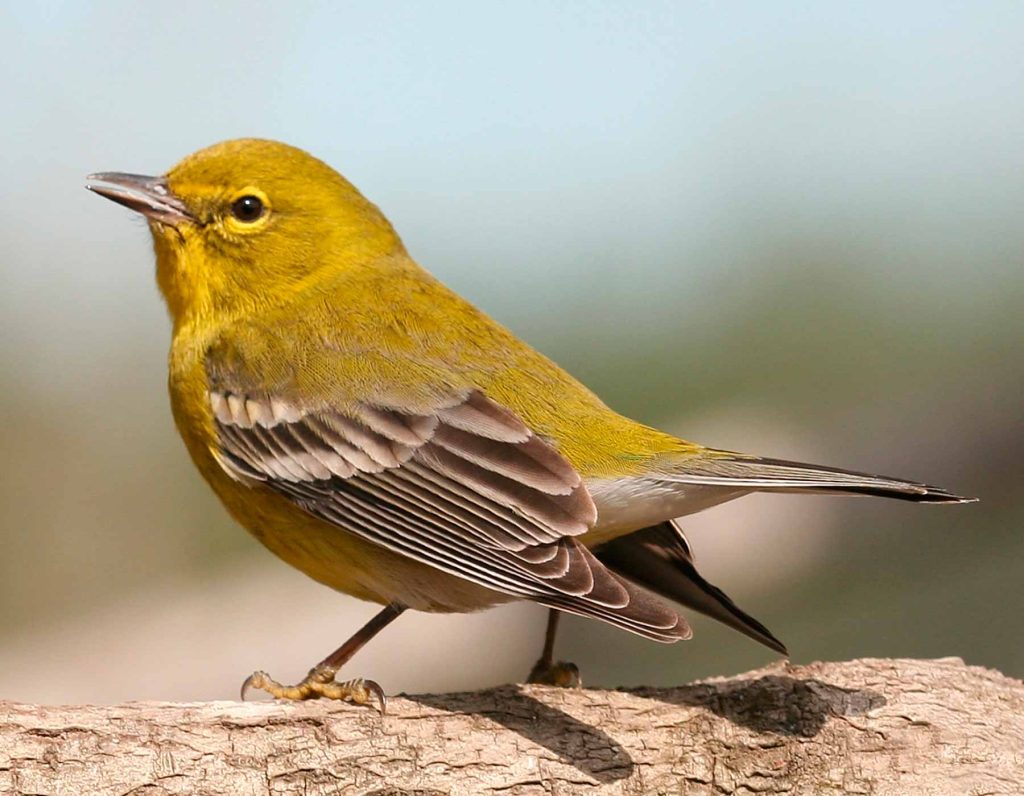
During the summer months, Pine Warblers grace the landscapes of New Brunswick, particularly from mid-April to July. However, some individuals remain in the region throughout the year.
Pine Warblers are small and plump birds adorned in yellow plumage with olive backs, white lower bellies, and gray wingbars. Females may appear slightly browner and exhibit more white on the belly.
Scientifically referred to as Setophaga pinus, Pine Warblers measure around 5.1-5.5 inches (13-14 cm) in length and weigh approximately 0.3-0.5 ounces (9-15 g). With a wingspan of 7.5-9.1 inches (19-23 cm), these warblers predominantly breed in northeastern US states before heading to southeastern US states. However, some individuals choose to remain year-round in the southeastern US states.
Pine Warblers find their preferred habitats in pine forests, as suggested by their name, often perching high up in the trees. They primarily feed on caterpillars, beetles, spiders, and other insects and larvae. When the weather turns colder, they incorporate fruit and seeds into their diet.
To attract Pine Warblers to your yard, consider installing tube feeders and platform feeders stocked with millet, cracked corn, sunflower seeds, peanut hearts, and suet. Additionally, planting native fruit-bearing plants and vines like bayberry, grape, sumac, and Virginia creeper can be enticing.
Fun Fact: Pine Warblers stand out among warbler species as they primarily consume seeds, making them more likely to visit backyard feeders.
15. Wilson’s Warbler
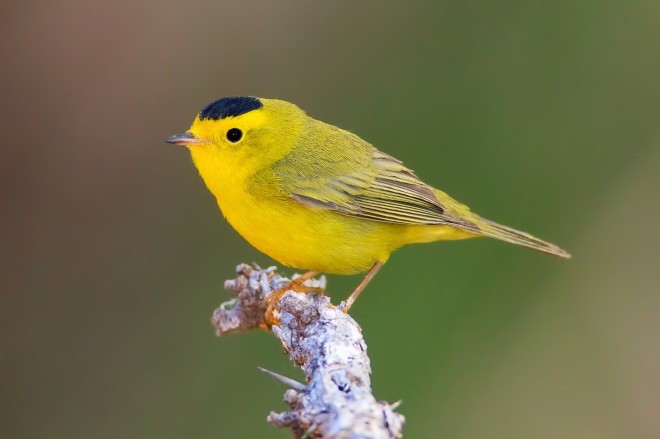
During the spring and fall migration, Wilson’s Warblers can be observed in New Brunswick.
Wilson’s Warblers are diminutive, round birds dressed in bright yellow feathers. Males boast a large black cap, while females sport a smaller black cap.
Scientifically known as Cardellina pusilla, Wilson’s Warblers measure around 3.9-4.7 inches (10-12 cm) in length and weigh approximately 0.2-0.3 ounces (5-10 g). With a wingspan of 5.5-6.7 inches (14-17 cm),
these warblers breed in Canada, Alaska, and northwestern US states. However, during migration, they can be spotted across all US states. For the winter, they migrate to Mexico and Central America.
Wilson’s Warblers prefer habitats along streams, thickets, and forest edges, where they actively forage for insects, larvae, and spiders.
To attract Wilson’s Warblers to your backyard, focus on planting native trees and shrubs. However, note that they do not typically visit feeders.
Fun Fact: Wilson’s Warblers employ a clever strategy to distract potential nest predators. They pretend to have a broken wing, luring the predator away before flying off to safety.
16. Canada Warbler

While not commonly seen in New Brunswick, Canada Warblers occasionally make appearances from mid-May to September.
Canada Warblers bear a resemblance to Magnolia Warblers and share a similar range. However, they feature a grayish-black back and a “necklace” of black in males, which does not extend over the belly but only across the chest. They showcase yellow chests, bellies, and throats.
Females and immature Canada Warblers exhibit a similar appearance but appear paler on the back, with a less prominent “necklace.”
Scientifically referred to as Cardellina canadensis, Canada Warblers measure around 4.7-5.9 inches (12-15 cm) in length and weigh approximately 0.3-0.5 ounces (9-13 g). With a wingspan of 6.7-8.7 inches (17-22 cm), these warblers breed in Canada and northeastern US states. However, they can also be spotted during migration across the eastern half of the US. For the winter, they journey to western South America.
Canada Warblers are often found in conifer forests filled with rhododendrons or aspen and poplar forests, where they actively forage for insects and spiders. Locating them can be challenging, as their population numbers have been declining.
Fun Fact: Canada Warblers are incredible flyers, covering over 3000 miles each way during their migratory journey between their summer and winter grounds.
17. Orange-crowned Warbler

While infrequently seen in New Brunswick, Orange-crowned Warblers have occasionally been spotted during the fall migration, particularly from September to December.
Compared to other warblers, Orange-crowned Warblers lack the vibrant coloration, featuring a yellow-olive plumage, which leans more towards yellow on the Pacific Coast. Their orange crown is rarely visible.
Scientifically known as Leiothlypis celata, Orange-crowned Warblers measure around 4.3-5.5 inches (11-14 cm) in length and weigh approximately 0.3-0.4 ounces (7-11 g). With a wingspan of 7.5 inches (19 cm), these warblers breed in Canada and western US states before embarking on a migration that covers the Pacific, East, and Gulf Coasts, as well as Mexico. They can be observed during migration in all US states, except for the northeastern region.
Orange-crowned Warblers can be found in shrubs and low-lying vegetation, although they prefer open woodlands for breeding purposes. Their diet mainly consists of spiders and insects such as caterpillars and flies. They also incorporate fruit, berries, and seeds into their food choices and regularly visit backyard feeders.
To attract Orange-crowned Warblers to your yard, consider offering suet and peanut butter or setting up hummingbird feeders filled with sugar water nectar.
Fun Fact: Orange-crowned Warblers are known to drink from the sapwells created by sapsuckers and woodpeckers.
18. Scarlet Tanager Female
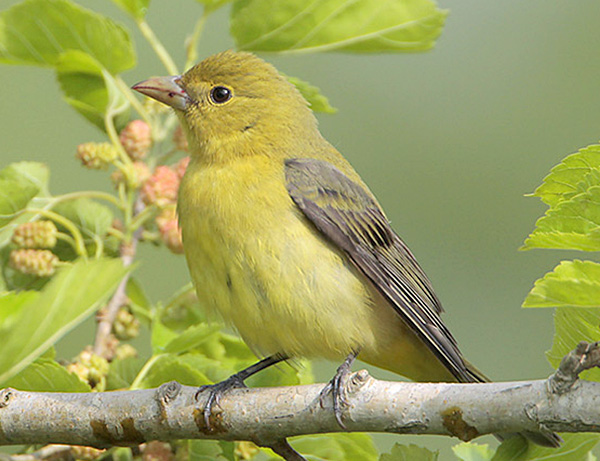
Scarlet Tanagers are seldom observed in New Brunswick, but they occasionally grace the province during migration.
Female Scarlet Tanagers feature yellow plumage with darker wings and tails, mirroring the post-molting appearance of males.
Male Scarlet Tanagers are resplendent in their bright red attire, with contrasting black wings and tails. They possess thick bills and exhibit short tails.
Scientifically referred to as Piranga olivacea, Scarlet Tanagers measure around 6.3-6.7 inches (16-17 cm) in length and weigh approximately 0.8-1.3 ounces (23-38 g). With a wingspan of 9.8-11.4 inches (25-29 cm), they breed in eastern forests before embarking on a migration to western South America. During migration, they can be spotted in southeastern US states.
Scarlet Tanagers prefer to stay high in the forest canopy, making them challenging to spot. However, their presence may be signaled by flashes of red as they traverse branches while foraging for insects.
To attract Scarlet Tanagers, consider planting berry-producing plants such as blackberries, raspberries, huckleberries, juneberries, serviceberries, mulberries, strawberries, and chokeberries.
Fun Fact: Male Scarlet Tanagers engage in singing battles that sometimes escalate into actual physical conflicts.
19. Eastern Meadowlark
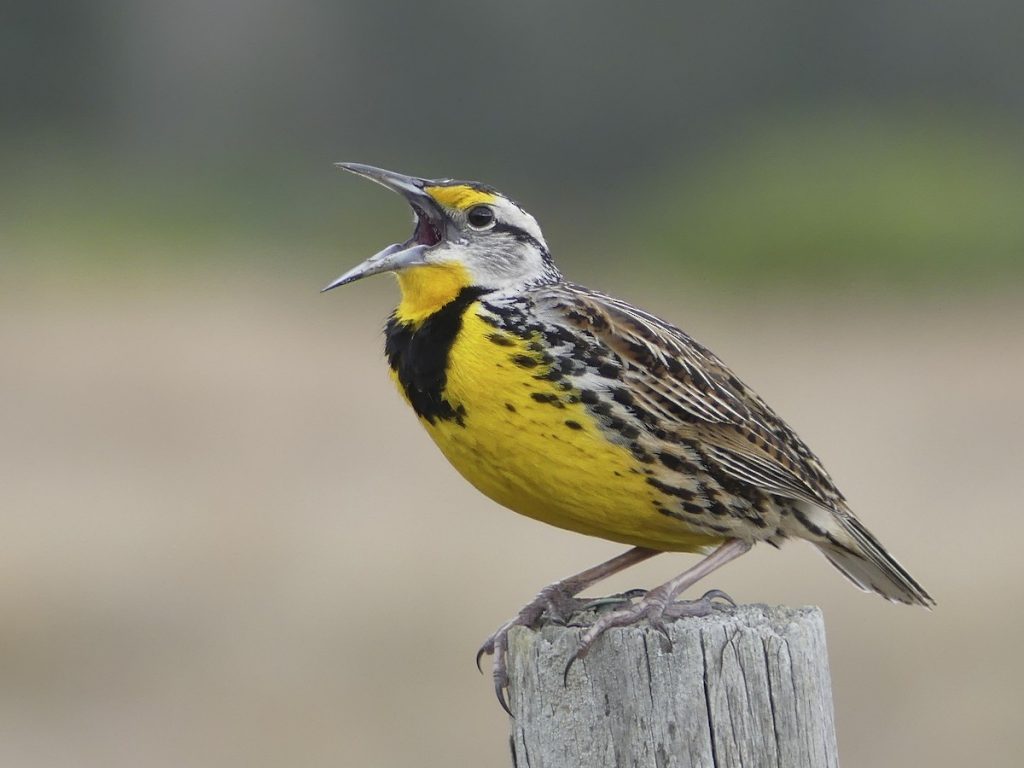
Eastern Meadowlarks, considered a near-threatened species in New Brunswick, are not commonly sighted. However, a few records exist of their presence in the southern parts of the province during summer.
Eastern Meadowlarks are medium-sized songbirds displaying bright yellow undersides and pale brown plumage adorned with black marks on their backs. They bear a distinctive black band across their chests.
Scientifically known as Sturnella magna, Eastern Meadowlarks measure around 7.5-10.2 inches (19-26 cm) in length and weigh approximately 3.2-5.3 ounces (90-150 g). With a wingspan of 13.8-15.8 inches (35-40 cm), they can be found year-round across eastern US states. They breed not only in the East but also in the Northeast and Canada before embarking on a southern migration.
The arrival of spring is often heralded by the melodious songs and captivating displays of Eastern Meadowlarks. Unfortunately, their near-threatened status indicates a decline in population numbers.
Eastern Meadowlarks prefer grasslands and prairies, where they forage on insects. During winter, they gather in large flocks, searching for seeds in fields.
